 |
 |
| 織部研究会 Oribe Study Circle (Photos taken on Feb. 2, and Mar. 30, 2003) |
| 織部研究会は2002年10月5日に第1回が始まり、2003年3月30日の5回目で完了と なりました。以下に研究会の様子をご案内します。 The 1st time started on October 5, 2002, and the Oribe Study Circle was completed by the 5th time on March 30, 2003. I show below to the situation of this Circle. |
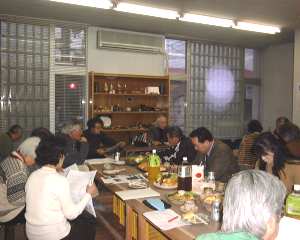 |
| 陶芸家の寺田康雄氏(陶芸作品陳列ケースの手前左側)が会の世話役、 名古屋工業大学名誉教授の国分氏(陳列ケースの手前右側)が講師となり 全5回で織部に関する研究が陶器のみならず地理、歴史、流通経済、自然災害等 の観点から史実を基に発表されました。多少、内容が堅いですが、史実に沿って、 柔らかい部分も絶妙に適度にちらばめられ、地味ではありますが、味わい深い講義 でした。また陶器や窯の話になると、専門家である寺田氏から合いの手が入り、 メリハリの利いた楽しい、興味深い講演となりました。 Mr. Yasuo Terada, ceramic artist was a mediator of this Circle, and Mr. Kokubu, emeritus professor of Nagoya Institute of Technology became the lecturer. The lecture regarding Oribe-ware with all the 5 times was done on the basis of historical fact from viewpoint such as history, circulation economy and natural disaster as well as ceramics and geography. Although the contents of a lecture were hard somewhat, it was inlayed with soft portions in accordance with the historical fact moderately and exquisitely, resulting in the deep tasted lectures. Moreover, when it came to a china or kiln, a kind of the interlude with expertise entered from Mr. Terada who is a specialist, and the lecture became lively and interesting. 上の写真は第3回目の研究会の様子です。 日時 2002年2月2日 午後5:00〜7:00 場所 美山陶芸教室 会費 1000円 定員 30名 The above photo shows the situation of the 3rd Study Circle. Time: 17:00 - 19:00 on Feb.2, 2002 Place: Bizan Ceramic Art Classroom Fee: \1,000.- Capacity: 30 persons |
| 第5回(最終回) 織部研究会 [2003年3月30日] |
| 寺田氏のお取り計らいで午後1時からバーベキューなどを囲んでの親睦 パーティーと楽焼きが美山陶房の敷地内で催されました。楽焼きが完了後、 美山陶芸教室にて国分教授の講義が午後4時半から午後6時まで行われ、 その後30分間は国分教授への活発な質疑応答で本研究会は終了しました。 以下に楽焼きの様子を取り敢えず写真でご紹介します。 講演内容は後日、掲載予定です。 |
|
| A friendship party and the firing of Raku-Ware
were held in the site of Bizan Workshop, eating a barbecue from 1:00 p.m. by Mr. Terada's arrangement. After completion of the firing, Professor Kokubu's lecture is performed from 4:30 p.m to 6:00 p.m. in the Bizan ceramic art classroom. Then, this study group was ended by the active questions and answers to Professor Kokubu for 30 minutes. I introduce the situation of the firing of Raku-Ware below with a photographs. The contents of the lectures will be shown later. |
| 陶芸家寺田康雄氏(左側) Ceramic artist, Mr. Yasuo Terada (left hand side) |
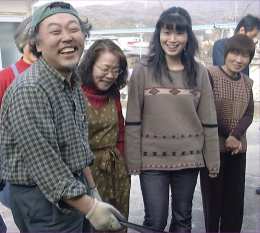 |
| 素焼き(注2)の陶器と釉掛け Pottery of and the Glazing on Biscuit firing (Note 2) |
焼成のため窯内エンゴロへ Into sagger in the kiln for firing |
楽焼き窯(注1)の蓋をする Put a cover on the kiln for Raku-Ware (Note 1) |
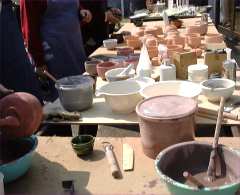 |
 |
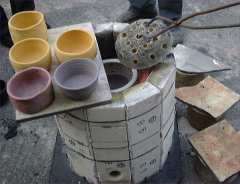 |
| 焼成中(還元から酸化へ) Under firing (from reduction to oxidation) |
焼成完了 Completion of firing |
焼成途中で引き出し Pulling out in the middle of firing |
 (Note 3 Glazing agent)) |
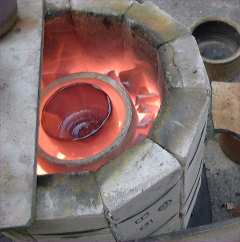 |
 |
| 引き出した陶器をエンゴロへ Into sagger of the pulled out pottery |
水に漬けて冷却 Soak in water to cool |
焼成完了品(注3) Fired work (Note 3) |
 |
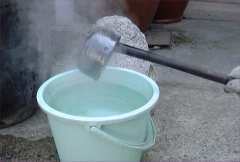 |
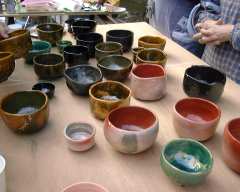 |
| 特に印象に残った焼成品1 A fired pottery 1 which impressed me |
特に印象に残った焼成品2 A fired pottery 2 which impressed me |
各種雑木の灰で作った釉薬 が入っている大壷 Large jars with glazing agents made from the ashes of various miscellaneous trees |
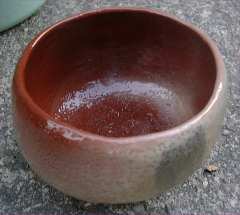 |
 |
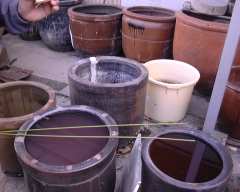 今回の釉掛けには使用しない The glazing agents are not applied this time. |
| 《注 Note》 1 楽焼き窯 寺田氏がデザインされ、スタッフに作ってもらった窯。各地で実演される時にこの 窯を使用されるそうです。窯内部の温度は約1000℃。登窯、窖窯、大窯等とは 違い、低温であるが短時間で焼成できる。また、窯内部での焼成状態は還元から 酸化焼成に変化してゆく。 1 Kiln for Raku-Ware The kiln was designed by Mr. Terada and made by his staff. Seemingly, this kiln will be used when demonstrating in various places. The temperature inside the kiln is about 1000 ℃ . The kiln for Raku-Ware is different from Noborigama kiln (climbing kiln), Anagama kiln (concave-like kiln with one firing chamber and with the ceiling ; the kiln is made on the slope of a hill side) and Ohgama kiln (like Anagama built on the earth). The temperature inside the kiln is lower than the one inside those, but pottery can be fired in a short time. The firing is changed from reduction to oxidation. 2 素焼き 土は楽焼き用に瀬戸市で採った土です。 2 Biscuit firing The china clay digged at Seto was used for Raku-Ware. 3 釉薬 釉薬は全て、ここで作られたものです。 1)黄色の釉薬は中国黄土→焼成すると写真「印象に残った焼成品1と2」のように、 紫がかった赤色になります。焼成品1の緑色やグラデーションがかった個所は、 窯の内部で燃料の炭が灰となり、灰かぶりのためと温度変化のためと思われます。 2)ねずみ色の釉薬→瀬戸黒。 3)紫色の釉薬→緑の織部 3 Glazing agent All the glazing agents were made here. 1) Yellow glazing agent is produced from yellow clay in China. When firing, the color of the china body becomes red inclining to purple as shown in photos, "A fired pottery 1 and 2 which impressed me" . Green or graduated color shown in the pottery 1 seems to come from the following: * The charcoal of fuel serves as ashes inside the kiln and the ashes are applied on the clay body. * Temperature change inside the kiln 2) Grey glazing agent → When firing the china body with the agent, it becomes black called "Seto-guro". 3) Purple glazing agent → When firing the china body with the agent, it becomes green called "Ao-Oribe". 4 アメリカ楽とかウエスタン楽 日本の楽から影響を受けている。外国人は、「赤く焼けた状態の陶器を窯から取り出し 冷やし、完成させる迄を短時間で出来る」事に魅力を感じるようだ。 4 America-Raku or Western-Raku America-Raku or Western-Raku is influenced by Raku in Japan. Foreigners seem to feel charm for the following: You can pull out the burned red pottery from the kiln, cool, and complete for a short time. 5 引き出し黒 焼成の途中で窯から引き出すという手法は日本だけのものらしい。 引き出した後に徐冷すると、茶色が褐色になり、急冷すると黒になるようです。 5 Pitch dark color Pitch dark color appeares on the fired pottery when pulling out it in the middle of firing. Such "pulling out" method seems to be proper to Japan. When cooling gradually after the pulling out, the color of the fired pottery becomes brown. When cooling rapidly, it becomes black. 6 非常に不思議な風説「一楽二萩三唐津」が茶の湯では広まっているらしい。 恐らく 茶の湯の世界の権威とか自称する、勉強不足の狭量な趣味人が陶器の歴史の重さを 理解せず、一部の陶器産地のプロパガンダに踊らされている現象かもしれません。 7000年以上の焼物の歴史があり、現在も陶器・陶磁器を生産しているのは日本では 瀬戸市だけであり、ましてや、安土桃山時代以前から、釉薬を作り施釉陶器を焼く技術 を持っていたのは瀬戸だけであり、その為、千利休や古田織部の茶の湯用の要求に 応える茶碗を焼成できたのは瀬戸・美濃だけであるのに、奇妙な風説があるものです。 6 Very strange rumor seems to get around in the world of tea ceremony. The rumor says , "1 Raku, 2 Hagi and 3 Karatu". It may be a phenomenon where narrow-minded people with hobbies but with insufficient study who call themselves authority in the world of the tea ceremony do not understand the weight of the history of ceramics and dance in accordance with the propaganda from some places of ceramics-production. It is only Seto City that has history with more than 7,000 years and still continues to produce pottery/porcelain in Japan at present. Moreover, before 1568 (the begining of Azuchi-Momoyama era), the potters in only Seto owned the technique to firie the china clay with glazing agents. So, only Seto and Mino could fire the tea bowls so as to meet with the demand from Mr. Senno Rikyuu and Mr. Furuta Oribe in tea ceremony How queer the rumor is. 7 長次郎と楽焼き 長次郎については奥野秀和氏のウェブページ《楽「長次郎」研究》へのリンク参照。 楽焼きについて《京の特選「陶芸・吉村楽入工房」》へのリンク参照。 7 Chojiro and Raku-Ware As for Chojiro, please see the following web page of Mr. Hidekazu Okuno "Stiudy on Chojiro" (only in Japanese) As for Raku-Ware, please see the following web page. Choice of Kyoto "Ceramic Art - Yoshimura Atelier for Raku-Warw " (only in Japanese) |